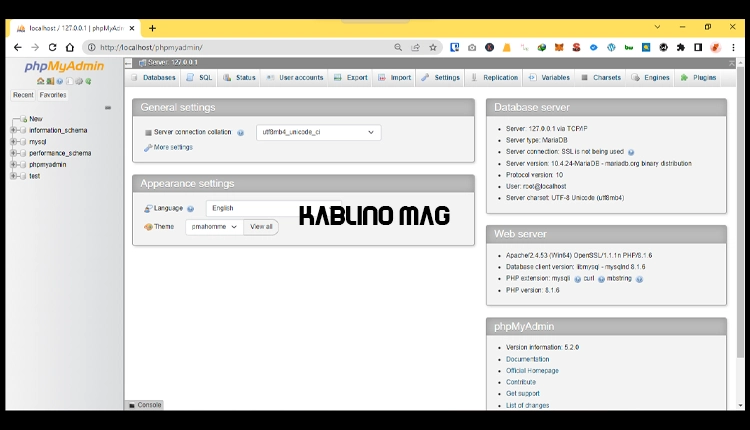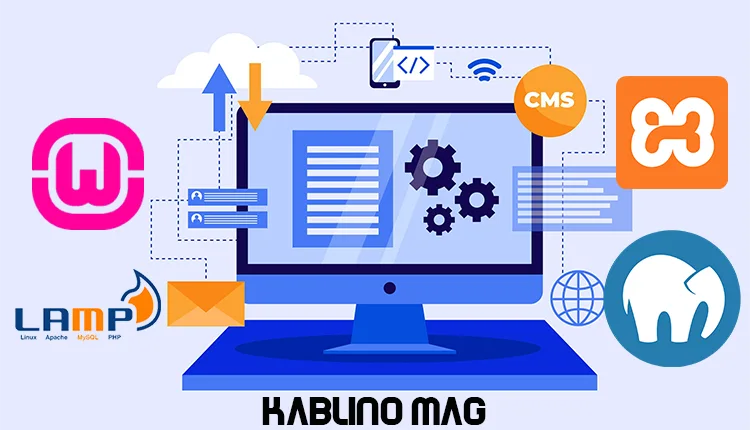Kablino Mag
What is XAMPP? (zero to hundred) | Comparison with similar programs XAMPP

Table of contents (quick access)

XAMMP is a free software cross-platform web server. which consists of Apache HTTP server, MySQL database and a PHP and Perl script interpreter.
Released under the GNU GPL license and completely free, this program is a web server that can serve dynamic pages. Zemp currently works on Windows, GNU/Linux, Solaris, and Mac OS X.
- Developer(s): Friends of Apache
- Stable release: January 19, 2021; 16 months ago
- Operating system: Linux, Microsoft Windows, Solaris, Mac OS X
What is xampp software?
XAMPP software is an open-source software that includes Apache distributions for servers and is basically for running localhost or a local server. XAMPP software provides you with a platform to install products, Apache, MariaDB, PHP, Perl on your operating system at once without the need for additional settings. XAMPP software is used to install, test, program and run web software on the web server of various operating systems for programmers.
What are the advantages of using xampp?
What is the use of xampp software? As an app developer, you need to test every app multiple times to find and fix bugs. If you use Zemp software in a local environment for testing, this process will definitely speed up your development process.
Testing on a live server would be very difficult. But in XAMPP you can easily test and update on your localhost.
What is the use of xampp software?
Apache
It is an open source software. Apache HTTP is a remote server (computer) if someone requests a file, photo or document using their browser, the server provides these files to users using HTTP servers.
prell
It is a general purpose programming language. This language is used for web development, GUI development, system management and Perl is capable of working with HTML, XML, and other markup languages. What is the use of xampp software?
oppenssl
It is one of the most widely used tools in the field of SSL. SSL certificates are now in high demand. Since the start of the “HTTPS First” campaign, they introduced SEO as an incentive to install digital certificates, and later, Chrome made HTTPS mandatory for all websites. If you do not use an SSL certificate, popular browsers such as Chrome and Firefox will not consider your site as a “secure” website.
In the latest version of XAMPP, there are other tools such as Mail server Mercury, OpenSSL, Php My Admin and…
Application of Xampp in design and development
After installing the ZAMP software, all its modules will be available with one click. In fact, by building a local host, this software provides the developer with the ability to run PHP and Perl programs.
Before the existence of this software, the developer had to test and check the web application files in a real server environment; Preparing a server or host is expensive and it will not be economical to test several web applications.
One of the best features of Xampp is the implementation of various CMS. The web designer can make a copy of his WordPress website and run it on the localhost, and every time it comes to update the website or add a new feature, test it on the localhost before doing it on the real server. and if the process is successful, do it on the real server as well.
Xampp modules
At the beginning of the article, we said that the Xampp software consists of 4 main modules, which are:
- Apache
- php my admin (MySQL database)
- PHP compiler
- Perl compiler
In this section, we describe these modules.
What is Apache web server?
Apache Apache is one of the most common free and open source web servers in the Internet world. The task of this module is to display content written with HTML and CSS styles in the web environment. In fact, it can be said that Apache is an HTTP Server background execution software. Apache is an intermediary between the client and the server and provides the client’s requests to the server and on the other hand, displays the content received from the server under a protocol such as HTTP to the client who is the user.
Previous versions of Apache ran on Linux, but during recent updates, it can also run on Windows and Mac.
Apache web server features
Apache web server has a series of features that distinguish it from its competitors, these features include:
- Simple configuration
- High security
- Stable and flexible
- Suitable for WordPress websites
- Open source and free even for commercial purposes
Apache is not the only web server in the world of the Internet and it has competitors such as Lightspeed, Nginx, Lighttpd and ISS, but Apache is the most common and widely used web server.
What is PhpMyAdmin?

PhpMyAdmin is one of the most common software for MySQL database management.
In fact, you can easily implement all kinds of operations on the MySql database through the PhpMyAdmin module available in Xampp. Some of the features of PhpMyAdmin are as follows:
- MySQL database management
- MariaDB database management
- Managing users and their access permissions
- Search across databases
- Web interface
- Create and drop the database
- Database backup in XML, CSV, SQL and PDF formats
- Restore database with CSV or SQL formats
PhpMyAdmin is cross-platform and can be installed on different operating systems.
What is localhost?
Localhost refers to a space that users create on their computer with the help of software such as Xampp and test or develop a web application or website in it.
Localhost was created so that web developers do not have to deal with slow internet speed or such problems for a simple web application test.
The services that run on the local host can only be seen by the site administrator and no one else has access to it.
One of the reasons every web developer should get familiar with localhost is its free and constant availability. In order to avoid unwanted errors when running the web application on the main server, web developers must first run their service on the local host and debug it in that environment, and transfer it to the main server safely when the project is completed.
What words does XAMPP program stand for?
The letter X stands for Cross-platform, which means that this software can be used on different types of computers or different software packages. Different local systems have different configurations of operating systems installed on them. The creators of this software have included the Apache distribution package in order to increase its usefulness and audience. This software supports different operating systems such as Windows, Linux and MAC OS packages.
The letter A stands for Apache server, meaning that the XAMPP software package includes Apache web server distributions for the server. Apache is a cross-platform HTTP server used worldwide to serve web content. Apache web server delivers files, images and other requested documents to the user.
The letter x stands for MariaDB, meaning that the XAMPP software has a MariaDB database instead of MySQL. Originally, MySQL was part of XAMPP, but now it has been replaced by MariaDB. This software is one of the most widely used relational databases created by MySQL.
The letter P stands for PHP and Perl, which means that this software offers PHP and Perl programming languages.
PHP is a backend programming language primarily used for web development. PHP allows users to create dynamic websites and applications. PHP stands for Hypertext Processor. Perl is a combination of two high-level dynamic languages, Perl 5 and Perl 6. Perl can be used to find solutions to problems based on system administration, web development, and networking. Perl also allows its users to program dynamic web applications.
Comparison of XAMPP software with similar software

Comparison of XAMPP software and WAMP software
Both XAMPP and WAMP are open source and free, which means anyone can download and use them without payment or restrictions. Both products are also designed as packages that help you set up your own server environment on your local machine. Using WAMP and XAMPP you can automatically install Apache, MySQL, PHP and a few other custom components and services.
These software products also have simple and user-friendly control panels through which you can configure the components easily and if necessary. Using both of these products, most important actions such as turning off or turning on a certain service can be done with one click.
Despite the similarities between these two software, there are some minor differences between XAMPP and WAMP software.
XAMPP software was developed by Apache Friends, a non-profit organization founded in 2002.
WAMP was created by a French engineer named Romain Bourdon, who started this project in 2003
XAMPP offers a major advantage of compatibility with a variety of operating systems. In this software, three different versions are available for Windows, Linux and Mac.
But WAMP limits users because they cannot use those systems with operating systems other than Windows 32-bit or 64-bit.
While the file size for both packages is relatively small, the WAMP file size is almost four times the size of XAMPP. XAMPP is 149 MB for both Windows and Linux operating systems and 158 MB for Mac. But, the 64-bit version of WAMP for Windows is around 518 MB.
Most users find it much easier to install and configure XAMPP. After launch, the installer will ask you which components from the package you would like to install. This is the only decision-making part involved in installing XAMPP.
On the other hand, WAMP has confused a lot of people, especially those trying to run WAMP on other operating systems than Windows.
As with XAMPP, WAMP home page has some basic instructions on how to install the software, but they are very brief, which is not useful for a beginner.
Both product websites have forums where you can ask questions and get answers from helpful developer community members. However, XAMPP fans have a much more active community, so XAMPP users can easily find solutions to their problems.
XAMPP project files are stored in the htdocs folder in the installation folder, while for WAMP, you can put your project files under the “www” folder, which is in the “wamp” installation directory.
Comparison of XAMPP software and LAMP software
Lamp is intended for the Linux operating system. The idea of using the word LAMP was first given by Mr. Michael Kunze in a German magazine in 1998.
LAMP is an open source web development platform that consists of four layers.
It uses Linux as an operating system, Apache as a web server, MySQL as a database management system, and PHP as a programming language.
Sometimes you can use Perl or Python instead of PHP programming language.
Because the platform has four layers, LAMP is sometimes referred to as layer LAMP.
Comparison of XAMPP software and MAMP software
XAMPP software runs very fast.. Installing the files is easy, you just put the installation file in the htdocs folder and you are ready to work. This software has good support for phpmyadmin using the client interface.
MAMP stands for (M (Mac OS X) A (Apache) M (MySQL) P (PHP, Perl, Python). This software, like XAMPP, easily supports web development. You install the program, save the files in Put the required folder of the programs, now your software is ready to use.
MAMP works in the same way as XAMPP, although there are some minor differences. including three advanced features such as port assignment, PHP optimization and the ability to change the start list.
Of course, MAMP also has negative aspects. It doesn’t seem to be as smooth as XAMPP. For example, it shows the port number in the address bar, starts and stops, and also has slower execution.
If you have any questions, share them in the comment section.
